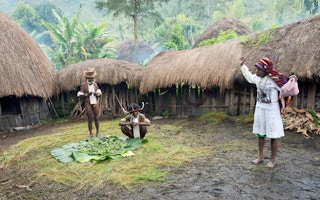In April 2015, over a quarter of a million people flocked to the National Mall in Washington for the Global Citizen Earth Day concert. They urged leaders to take action to protect our planet and its people from the devastating effects of climate change.
This call to action is timely as the United Nations begins the transition from the Millennium Development Goals (MDGs) established 15 years ago, to a new global sustainable development agenda be adopted by world leaders at the UN General Assembly in September, and as it prepares for the United Nations Climate Change Conference in Paris in December.
These conversations are also relevant as the United Nations has just finished hosting the Indigenous Peoples’ Forum, followed by the United Nations Forum on Forests.Close to 1.6 billion people – more than 25 percent of the world’s population – rely on forests resources for their livelihoods. Approximately 1.2 billion use trees on farms to generate food and cash. Of these an estimated 60 million are indigenous peoples.
Indigenous people are, by definition, outsiders, due to their geographic and political remoteness. They make up anywhere from 5 percent of the world’s population and anywhere from 10 percent to 30 percent of the world’s poorest people, according to the UN. Yet they hold the vital knowledge of generations on how to live with nature and be in balance and harmony with the natural world.
While preparing for these summits we must address the unfinished business and refocus development planning on the most vulnerable. We must leave no one behind, and this includes building a strong framework for sustainable forests and including indigenous peoples in the decision-making process.
Recently, I went on a mission to Indonesia and Vietnam accompanied by fellow members of UN Secretary-General Ban Ki-moon’s MDG Advocacy Group, Dho Young-Shim and Stine Bosse. The purpose of these visits was to highlight and investigate promising examples of climate and forest cooperation between Indonesia and Norway. It was also call attention to the fact that indigenous peoples need to be included in the final year of MDG efforts and subsequent global development frameworks and to listen to their experiences in their own words.
We visited the exquisite Bujang Raba rainforest ecosystem on the island of Sumatra where the Orang Rimba live, one of Indonesia’s most vulnerable indigenous tribes. Their worldview, like that of most indigenous communities, was of a sacred obligation to bequeath a healthy forest fully capable of providing life to its human inhabitants to future generations.
“
We must leave no one behind, and this includes building a strong framework for sustainable forests and including indigenous peoples in the decision-making process.
The culture and livelihood of these people are intertwined with the forest ecosystem. They make an average of between $1.30 and $1.80 per day; yet their biological adaptation, together with their spiritual beliefs, demands that they utilise the forest in a sustainable manner.
Threats to their forest and livelihood include logging, and palm oil and rubber plantation development. These lead to deforestation, soil degradation and erosion that causes chemical run-off into local waterways and poisons drinking water.
Coal mining has also caused a great deal of biodiversity loss and their traditional land tenure rights are in conflict with rubber and palm oil companies’ interest in the area. Despite this, for the first time in Indonesia, indigenous communities have been given legal rights to forest areas through a ruling of the constitutional courts in the customary forest area (Hutan Adat).
This is a small, but significant success story made possible by the REDD+ (Reducing Emissions from Deforestation and Forest Degradation) project work over the past five years. Moreover, a meeting we had with business leaders within the palm oil industry on Sumatra was promising in terms of a shift towards sustainable production.
From Sumatra, we traveled to Vietnam, one of the great success stories of the MDGs. In Lao Cai province, they have succeeded in reducing emissions from the forest sector to prevent negative effects of climate change through forestry projects, including the UN-REDD+ Programme.
We met with forest rangers, local authorities and representatives of the local community who help protect watersheds, prevent landslides and provide livelihoods for local communities, thus contributing to sustainable development. One local man said he learned the importance of forest preservation, and that assistance with alternative building materials received from project partners was very welcome.
Through its diligence, Vietnam has managed to increase its forest coverage from 27.8 percent in 1994 to 40 percent in 2010.
Today we know that with rapid climate change, one-fourth of Earth’s species could be headed for extinction by 2050. Climate change has already transformed life on Earth. Around the globe, seasons are shifting, temperatures climbing and sea levels are rising at alarming rates.
We have the knowledge needed to turn the situation around. At the global level, the New York Declaration on Forests coming out of the UN Climate Summit in September last year was an important milestone, with its focus on joining forces internationally and to act now. At the local level, promising examples such as those we saw in Indonesia and Vietnam prove we can turn environmental degradation around to build greener, more sustainable futures.
We must each do our part as global citizens to ensure that we use the opportunity of the new global sustainable development agenda to advocate for and set policies that include all people on our one planet. We must return to our roots, and nurture an environment that promotes sustainable growth. We must protect those who have lived in harmony with our planet, protecting it for our future.
As one of our greatest dreamers, Herman Melville, reminded us, “We cannot live only for ourselves. A thousand fibers connect us with our fellow men; and among those fibers, as sympathetic threads, our actions run as causes, and they come back to us as effects.”
Erna Solberg is Prime Minister of Norway and co-chair of the U.N. Secretary General’s Millennium Development Goals Advocacy Group. This piece is based on her reflections, together with those of Ambassador Dho Young-shim and Stine Bosse who are both MDG Advocacy Group members.This piece is republished from the Thomson Reuters Foundation.









